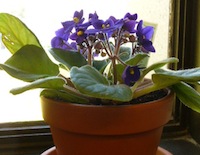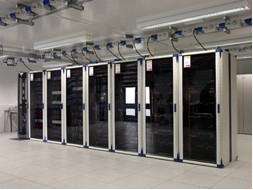March 2011 Archives
An office or dorm room may seem like an inhospitable place for plants. There is potential for inconsistent care, lack of abundant natural light, and people frequently leave for breaks or vacations, leaving their plants behind.
However, indoor spaces can greatly benefit from greenery - and not just by enhancing aesthetics and reducing occupant stress. NASA conducted a study showing that reduced air circulation in enclosed indoor spaces causes the accumulation of low levels of chemicals emitted by synthetic materials. This results in “Sick Building Syndrome,” where toxins become concentrated inside buildings, reducing indoor air quality and affecting occupant health. Many plants can counteract this effect dramatically. Here’s a list of some manageable plants that filter the air, and hardy plants that can survive no matter what.

Plants that reduce indoor pollution:
- Feston rose plant: low maintenance and low water, high tolerance of salt and high heat, plus gorgeous flowers in a huge range of colors.
- Devil’s ivy: keep it on a top shelf so it can climb down, soak it when the soil dries out, and don’t eat it.
- Phalaenopsis: has lovely white and pink flowers; can’t tolerate direct sunlight or over-watering.
- African violets: easy to maintain and thrives in moderate light and temperature.
- Chrysanthemums: a little fussier, needing daily watering, a lot of natural light, and trimming, mums are extremely effective in reducing indoor pollution.
- Other plants that reduce indoor air pollution include the Peace Lily and Garlic vine (don’t worry, it only smells like garlic when it’s been thoroughly crushed!).
Super low maintenance plants:
- Cactus: come in incredible variety and usually need only tiny amounts of water and care.
- ZZ, Zamioculcas Zamiifolia: hearty with sturdy green leaves, ZZ handles low light, low water use, neglect, and is tough indoors.
- Snake Plants: long upright leaves with striped patterns, should be watered infrequently and can withstand low light.
- Wandering Jew: preferring warm temperatures, direct sunlight, and somewhat frequent watering; this plant can be grown from just a cutting set in water. Its leaves have a striking pattern and are great to hang in a window.
- Madelyn Freed
Under the direction of IT Services, Facilities Services IT management team has been steadily switching its server platform from physical servers to virtual servers, also known as virtual machines (VMs).
So what is a VM and why is it more sustainable? A VM is a server that exists virtually and is therefore not tied to any one piece of hardware. If a simple example is helpful, think of Gmail and the way it works; the entire application is virtualized, none of your emails exist anywhere on your computer’s hard drive. A VM platform is a more sustainable way to manage computing tasks for at least two reasons, neither of which are normally possible with physical servers.
A VM platform allows for the full (usually about 85-90%) computing power of the underlying hardware to be utilized; this reduces electricity and material consumption.
When a VM platform is being employed, server operations can be fluidly reassigned across underlying hardware in a matter of minutes, making VMs much more adaptable to the changing needs of their clients. This greater adaptability reduces time and labor and thereby increases the amount of computing that can be done with fewer resources.
Because of these efficiency gains, a standard VM is both much smaller and uses far less energy than its physical server counterpart. A typical VM at the U of C uses only 13 watts of power on average, while a physical server uses 281 watts, making VMs much more sustainable.
Recognizing the increased sustainability of VMs, Facilities Services IT management team is going virtual. Facilities Services currently operates 42 servers, 27 of which are already virtualized. By the end of 2011, 32 of Facilities Services’ servers will be virtualized, with the remaining physical servers replaced by virtual servers upon their decommissioning. Facilities Services plans to eventually have its entire server platform virtualized.
Be sure to look for a forthcoming, comprehensive case studying outlining the other exciting ways in which IT Services at the U of C is using technology to become more sustainable.

Special thanks to IT Services personnel and SAGE Ambassador, Chuck Korponya, for helping to produce this post.
Photo courtesy of: http://mjrinfotech.com/; accessed 8 March 2011
Guest post by Forrest Scofield, a first year in the College and a College Council Representative
Over the past few months, the University of Chicago has become the latest to engage in the nationwide movement to reduce bottled water consumption. Green Campus Initiative, a student run organization at the University, has been working hard to promote this reduction. Recently, GCI partnered with the Student Government Assembly to expand awareness about the issue.

Myself along with Youssef Kalad, a third year Student Government representative, drafted a resolution in support of GCI’s movement. Three weeks ago, we presented the resolution to the Assembly and listened to their concerns and suggestions regarding bottled water consumption on campus.
The discussion that ensued was lively, and many insightful and constructive comments resulted from it. Concerns were raised about the lack of sustainable alternative sources of water on campus, especially for RSOs to use at events. Bottled water’s important role in large events like convocation was also a concern. Initially several representatives opposed the wording of the resolution; some thought it lacked a sense of direction and others thought the information lacked credibility. Several graduate students discussed the disconnect between the college and the graduate schools; several hadn’t heard of the initiative previous to the presentation. The majority of the graduate representatives expressed interest in connecting their divisions to the conversation.
Two amendments were eventually added to the resolution: one that expressed Student Government’s intention to reduce the availability of funding for bottled water at student run events, and another to include the deans of the graduate divisions to the list of notable recipients.
The resolution eventually passed 14-6. The negative votes seemed to be based on the semantics of the document, but in general the intentions of the resolution received warm support from the Assembly.
With the support of the resolution in hand, I will be working closely with Green Campus Initiative, Joe Sullivan, and the Office of Sustainability to expand our effort to the graduate schools and discuss ways to provide student organizations free and sustainable water alternatives.
For further information, please check out our Facebook page or shoot me an email at fscofield@uchicago.edu.
For more, view the final resolution and the Maroon’s coverage.
Photo courtesy of UChicago Students Against Bottled Water
The Sustainability Council Subcommittees have been hard at work on various projects across the campus this year. Here’s a quick summary of the projects each has been working on:
Closing the Loop/Composting Committee: They’re currently focusing their efforts to help green the annual SASA Cultural Show by eliminating bottled water, increasing the number of recycling bins, and providing attendees with the option to compost at the event. Volunteers from the Council and other organizations, as well as SAGE Ambassadors will be on hand to answer questions about what can and can’t be composted and recycled.
Community Outreach: This committee is working with local community garden leaders to schedule an informal gathering where needs, opportunities for collaboration, and other ideas may be discussed. They’re also exploring potential partnership opportunities with Encore, a local non profit clothing resale shop that recently opened in Hyde Park.
SWAP: This group’s aim is to reduce waste and increase reuse by coordinating opportunities for students and the campus community to swap or donate left over items at the end of the academic year. The subcommittee will begin by connecting smaller scale SWAPS that are currently already taking place on campus while working to involve more dorms.
Campaigns: This committee has been busy this quarter! In addition to working with the Closing the Loop/Composting Committee to green this year’s SASA Show, they’ve continued to increase awareness around the Try Meatless Mondays campaign. In conjunction with GCI, this subcommittee is also working to reduce plastic water bottle use on campus. The campaign has gotten quite a bit of press and is working with Aramark, the campus dining vendor, to provide alternatives to bottled water, such as hydration stations. This subcommittee is also considering filing a Freedom of Information Act (FOIA) Request for information about tap water quality. Furthermore, the ca
Earth Week: This subcommittee is planning the events for Earth Week 2011. The annual Earthfest will be held on Friday, April 22nd, from 11am - 2pm on the Main Quad. Details about the week’s events to come!
